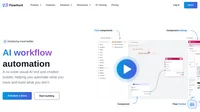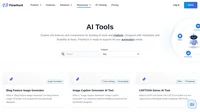Keras is a powerful and user-friendly open-source high-level neural networks API, written in Python and capable of running on top of TensorFlow, CNTK, or Theano. It was developed with a focus on enabling fast experimentation and comes with strong support for both production and research use cases. Originally developed by François Chollet, a Google engineer, Keras is designed to allow easy and fast prototyping through its modularity and simplicity. It has become a cornerstone in the field of deep learning due to its accessibility and ability to streamline complex computations into manageable tasks.
Key Features of Keras
- User-Friendly Interface: Keras provides a simple, consistent, and highly productive interface, which reduces the cognitive load on developers, allowing them to focus on crafting and innovating model architectures over dealing with technical complexities.
- Modularity and Extensibility: The framework is highly modular, enabling users to create custom layers, models, and workflows. It supports both simple and complex architectures through its Sequential and Functional APIs, allowing for a wide range of experimentation and customization.
- Cross-Platform Compatibility: Keras is platform-agnostic, which means it can run on various platforms and supports multiple backend engines, including TensorFlow, JAX, and PyTorch. This flexibility ensures that models can be developed and deployed across different environments, from CPUs to TPUs, and even mobile and web platforms.
- Scalability and Performance: Leveraging the capabilities of TensorFlow and other backends, Keras can scale from single-machine setups to large clusters of GPUs or TPUs, making it suitable for both small-scale experiments and large-scale production systems.
- Rich Ecosystem: Keras integrates with a vast ecosystem of tools and libraries. It offers pre-trained models, data loading utilities, and support for various machine learning tasks, including computer vision, natural language processing, and more.
- Fast Experimentation: With its high-level abstractions, Keras simplifies the process of prototyping and experimenting with different model architectures, which is crucial for exploratory work and rapid development cycles.
Structure and Components
Keras is built around two core components: layers and models. Layers represent the building blocks of neural networks, encapsulating both the state (weights) and computation. Models, on the other hand, are graphs of layers that can be trained and evaluated.
Models in Keras
- Sequential Model: This is the simplest type of Keras model, allowing you to build a model layer-by-layer in a linear stack. It’s ideal for models where each layer has a single input and output.
from keras.models import Sequential from keras.layers import Dense, Activation model = Sequential() model.add(Dense(units=64, input_dim=100)) model.add(Activation('relu')) model.add(Dense(units=10)) model.add(Activation('softmax')) - Functional API: Offers more flexibility by allowing you to define complex models with multiple inputs and outputs, shared layers, and non-linear topology. It’s suitable for sophisticated architectures like multi-branch networks.
from keras.layers import Input, Dense, concatenate from keras.models import Model input1 = Input(shape=(100,)) input2 = Input(shape=(50,)) hidden1 = Dense(64, activation='relu')(input1) hidden2 = Dense(32, activation='relu')(input2) merged = concatenate([hidden1, hidden2]) output = Dense(10, activation='softmax')(merged) model = Model(inputs=[input1, input2], outputs=output) - Model Subclassing: For use cases that require more customization, Keras allows you to subclass the
Modelclass and define your own forward pass using thecallmethod.
Use Cases and Applications
Keras is widely used in various domains for building and deploying deep learning models. Some common applications include:
- Image and Video Processing: Tasks like image classification, object detection, and video analysis leverage convolutional neural networks (CNNs) built with Keras.
- Natural Language Processing (NLP): Keras supports models for sentiment analysis, machine translation, and other NLP tasks, utilizing its sequential data processing capabilities.
- Time Series Forecasting: Models with LSTM or GRU layers are used for predicting time series data, applicable in finance, meteorology, and more.
- Healthcare: In medical imaging, Keras models assist in early condition detection, while in drug discovery, they predict molecular interactions.
- Autonomous Systems: Keras facilitates real-time data processing in robotics and autonomous vehicles, aiding in navigation and decision-making.
- AI and Game Development: Utilized in developing AI for games and simulations, employing reinforcement learning for adaptable gameplay experiences.
Integration with AI Automation and Chatbots
In AI automation and chatbots, Keras plays a vital role by providing tools to build robust models for natural language understanding, sentiment analysis, and dialogue systems. These capabilities are essential for creating intelligent chatbots that can interact naturally with users, understand context, and provide relevant responses. By leveraging Keras’s powerful features, developers can quickly prototype and deploy AI-driven chatbots that enhance user engagement and automate customer service tasks.
Keras: A Deep Learning Framework
Keras is a high-level neural networks API, written in Python, and capable of running on top of TensorFlow, CNTK, or Theano. It was developed with a focus on enabling fast experimentation. Below are several scientific papers that highlight the versatility and applications of Keras in various fields:
- VarteX: Enhancing Weather Forecast through Distributed Variable Representation
This paper discusses the challenges of weather forecasting with deep learning models, particularly the handling of multiple meteorological variables. The authors propose VarteX, a new framework that leverages Keras for efficient learning and variable aggregation. The model demonstrates improved forecast performance while using fewer parameters and resources. Through Keras, the study showcases the power of regional split training and multiple aggregations in weather predictions. Read more. - NMT-Keras: a Very Flexible Toolkit with a Focus on Interactive NMT and Online Learning
NMT-Keras is an extension of the Keras library, designed specifically for neural machine translation (NMT). It supports interactive-predictive translation and continuous learning, demonstrating the adaptability of Keras in developing state-of-the-art NMT systems. The toolkit also extends to other applications like image and video captioning, leveraging the modular structure of Keras for various deep learning tasks. Read more. - SciANN: A Keras/Tensorflow wrapper for scientific computations and physics-informed deep learning using artificial neural networks
SciANN is a Python package that builds upon Keras and TensorFlow for scientific computing and physics-informed deep learning. It abstracts neural network construction for scientific computations and facilitates the solution and discovery of partial differential equations using the physics-informed neural networks (PINN) architecture. The paper illustrates the use of Keras in complex scientific tasks, such as curve fitting and solving PDEs. Read more.



